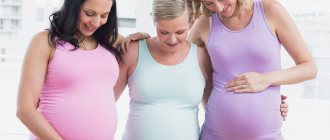About 30 years ago it was still believed that if a girl did not get pregnant immediately after the wedding, then something was wrong, and giving birth after 25 was very late. Nowadays, no one is surprised by a pregnant woman even after 40 years. Modern girls want to live for themselves, carefree, accumulate some capital, someone buys an apartment, a car.
Of course, everyone can manage their life as they want, only doctors and psychologists have their own opinions and arguments on this matter.
The point of view of official medicine
Doctors, unlike psychologists, have their own opinions about the optimal age for childbirth. The female body begins to blossom from the age of 19, it is completely ready for pregnancy:
- the formation of the internal genital organs is completed successfully;
- the ovaries maintain normal hormone levels;
- the vaginal muscles have achieved the required firmness and elasticity;
- the pelvic bones are quite mobile, which is important during childbirth;
- the abdominal press is strong and can help push;
- the girl does not yet have chronic diseases;
- During childbirth, there are generally no ruptures or complications;
- young women regain their physical shape faster.
Many gynecologists advise giving birth before the age of 30. The older a woman is, the less likely she is to get pregnant. Besides:
- Often such women in labor do not reach their due date;
- there may be a complicated course of pregnancy;
- Women over 30 years of age are 20% more likely to have complications.
Another important nuance: at this age, the risk of having a child with a pathology or congenital disease increases.
Physiological factors
The appearance of menstruation in a girl indicates that her eggs are ready for fertilization. But this does not mean that her organs are ready to bear and give birth to a child. The stress associated with bearing and giving birth to a child in adolescence is fraught with complications on the heart and kidneys, and there is also a possibility that the pelvic bones will not be able to separate properly, which is a direct contraindication for natural childbirth. Girls grow and develop on average until they are 18 years old, and this age can be used as a starting point.
Is there an extreme limit?
As long as you have menstruation and there are no compelling health contraindications, you can theoretically give birth. But at the same time, we must remember to use common sense. From the age of 25, the aging process begins in the body. A healthy lifestyle, proper nutrition, a culture of sleep and rest can delay visual aging, but you can’t escape from nature - by the age of 30, girls begin to experience progesterone deficiency, and testosterone levels increase accordingly, which is a risk factor for pregnancy. A girl under 30 years old, compared to more mature women, has more elastic birth canals and mobile pelvic bones, which also leads to the conclusion that from a physiological point of view, the best age for having children is 20-25 years. The age of 18-35 years is considered conditionally safe.
What's wrong with your father?
The participation of the male half in the physiological part comes down to his genetic material, that is, to the quality of sperm.
If in a woman all the eggs are formed at the stage of intrauterine development and new ones do not appear, then in men everything is much happier - sperm are able to change their qualities depending on his lifestyle. That is, if at the age of 50 a man does not drink, smoke or destroy himself in other ways, then his genetic material is not inferior to the sperm of a 25-year-old boy. Such a characteristic as sperm motility also does not directly depend on age, but in practice it is lower in 40-year-olds than in 30-year-olds. This means that a 40-year-old man needs to put in a little more effort to fertilize, but this will not affect the further development of the fetus.
If there is no upper limit for potential daddies, there is still a lower limit.
A teenage father runs the risk of passing on defective genes to his baby and increases the risk of having a child with low weight and developmental defects, since his own reproductive system is not yet properly regulated. Therefore, we will consider the physical start for a potential dad to be 16 years old, or better yet 18, so as not to violate the law.
We've sorted out the physiology, let's move on to a less tangible point - the psychological readiness of future parents for the birth of a baby.
READ ALSO: How to find out if your husband wants a child
You can't argue with the facts
Physiology
With the appearance of menstruation, pregnancy may already occur, but the body itself at this age is not yet ready for such a load. There is a risk of complications on the kidneys and heart; natural childbirth may be impossible due to improper divergence of the pelvic spines.
Full development ends by age 18. But after 25 years of age, the body begins to age. Progesterone levels decrease. Testosterone, on the contrary, increases, and this risks not carrying the child to term.
Total - physiologists for 20-25 years.
Psychology
Childbirth requires changes in your usual life for the well-being of the baby. A lot of girls who decide to give birth are not psychologically ready for this. Later, this may result in dislike for one’s own child, complaints against him, or result in depression of the young mother and poor relationships in the family.
Only after gaining the necessary social experience and passing (preferably) a readiness test can you become parents.
Total – 24-27 years.
Sociology
The little man not only needs the care and love of his mother, he also needs clothes, medicine, diapers, toys and many other useful things. Nowadays, all this is not so cheap.
So first, it is important to decide on a permanent place of work and earn authority there in order to have reliable financial support for caring for a small family member.
Total – 25-28 years.
Reviews from those who gave birth at different ages
The best age for pregnancy is different for each woman, but before becoming a mother, you need to think carefully about everything and assess your health. If there is any doubt, it is best to visit a specialist and undergo the necessary examination. When chronic pathologies are identified, one should not panic, since today patients with heart disease, kidney disease and bronchial asthma are successfully becoming mothers.
Women have different opinions about what age is considered optimal for having a child.
- Irina, 45 years old, Moscow: “I became a mother for the first time at 37 years old, and gave birth to my second daughter at 41 years old. Both pregnancies were easy, without any complications, and I gave birth naturally. With each child, I was discharged from the hospital on day 5, and there were no problems with breastfeeding. I believe that a woman needs to feel her body and focus on the state of her health, and not on bare numbers.”
- Alena, 41 years old, Samara: “I gave birth to my first child at 20 years old, and my second at 40, and I want to say that the age difference is big. With my first child, I fluttered like a butterfly, got up at night and gave birth without any problems. The second child appeared after 40 years, and age was already making itself felt. Labor was weak, so they placed an IV and there were many ruptures. I believe that it is best to give birth to a child before the age of 35, when the body is still in its prime. However, I do not mean those women who, due to life circumstances or health reasons, were unable to do this. My statement applies to those who believe that at 40, life is just beginning.”
About early pregnancy
It is strictly not recommended to become pregnant or give birth before the age of 16-18. A girl of this age has not yet reached full physical development. For the formation of the fetal placenta, the hormones progesterone and estrogen are needed, which are not enough in the young body. Complications, ruptures, and uterine bleeding are possible.
The future father cannot financially support his family, causing anxiety for the pregnant girl, disorder of her nervous system and depression.
On the part of psychologists, it is generally a categorical prohibition, since the girl does not have the moral readiness for a difficult life and maternal responsibilities.
Pregnant at 30-40 years old with her first child
Women of this age are quite responsible; they prepare for upcoming motherhood consciously and thoughtfully. They attend classes at the antenatal clinic and carefully monitor their health and regimen. In addition, they have prepared financially, and they have confidence in their prosperous future.
But a decrease in the hormone estrogen after 30 years can reduce the likelihood of conception or provoke a complex complication during pregnancy. This condition is accompanied by edema, decreased blood pressure, and the presence of protein in the urine, which can result in premature birth or death of the unborn child.
In addition, tissues that have become less elastic may rupture, which will require auxiliary, not harmless, operations by obstetricians. The placenta may begin to separate prematurely, water may break early, there may be insufficient strength for childbirth, uterine bleeding, hypoxia of the child’s brain.
Often, a baby born to a mother after 30 years of age has physical and mental disabilities, and the mother is at risk of developing breast cancer or diabetes.
Conditions for conceiving a child
If a woman could conceive a child only if she wanted, the birth rate could be maintained at the proper level. However, the female body is ready to continue the race for only a few days a month. For most girls, this is approximately the middle of the menstrual cycle. Directly at this time, ovulation occurs - the release of a mature egg from the follicle.
After exiting, the female reproductive cell is ready to merge with the male one. She has 24 hours to do this. After the specified time, degenerative processes begin in the egg, leading to reverse development. As a result, fertilization and conception become impossible. Considering these features, we can say that favorable conditions for conception are:
- mid-menstrual cycle;
- the period of ovulation in the female body.
What day of the cycle is best to conceive a child?
Conception is possible only during the ovulatory period. This means that a woman should at least know approximately when a mature germ cell is released in her body. In this regard, the question of how to calculate the day of ovulation for conception is relevant for all women planning a pregnancy. To determine when is the best time to conceive a child, you can use several methods:
- monitoring basal temperature;
- conducting a special test.
Based on the data obtained, you can determine when it is better to conceive a child after menstruation, and determine the days on which fertilization is most likely. According to statistics, every month a woman has only 6 days during which she can become pregnant. According to embryologists, this is 5 days before ovulation and 1 day after this process
. As a result, to establish the fertile window—the favorable time to conceive a child—you need to know exactly when ovulation occurs.
How to determine if you are ovulating?
It’s not enough just to know how to correctly calculate ovulation for conception, you need to make sure that it happens regularly. Even in an absolutely healthy woman, ovulation may not occur in every cycle. Every year, in 2-3 menstrual cycles, the release of an egg does not occur - an anovulatory cycle. As a result, it is impossible to get pregnant at this time, even if the girl actively makes such attempts. To avoid such situations, every woman should have a clear idea of how to find out if she is ovulating.
By carefully monitoring your well-being, you can determine with a high degree of probability when the egg is released from the follicle. So, approximately 2-4 days before ovulation, the volume of vaginal discharge increases. The consistency further thickens: the discharge becomes pasty, whitish in color and not so abundant. In addition, you can determine that ovulation is occurring in the body in the following ways:
- Measuring basal temperature.
Measuring the parameter values from the very beginning of the cycle, you can notice that approximately in the middle there is a decrease of 0.5 degrees. This is ovulation. - Special ovulation tests
are similar in appearance to those used to determine pregnancy.
How best to conceive a child - poses
Many believe that the likelihood of egg fertilization is related to sexual position. Doctors say that this fact cannot affect conception. However, women themselves, in order to increase their chances of pregnancy, in search of useful information, try to find the best positions for conception. If such exist, then from the point of view of the anatomy of the female genital organs, these are those that provide deeper penetration of the penis into the vagina.
By reducing the distance to the cervix, the likelihood of rapid delivery of the seed directly to the cervical canal increases. Taking this into account, the following positions can be considered ideal:
- woman on back, man on top;
- man behind, partner on all fours.
Is it dangerous to give birth after 40 years?
Doctors usually do not welcome such births, but there are not many of them - only 50% of women are able to get pregnant, and miscarriages are more common. The same risks and complications remain as after the age of 30.
Mostly healthy children are born, but the likelihood of congenital pathologies is high. A child may also be born with Down syndrome. But these women are less likely to get pelvic cancer. In addition, they live longer.
Psychologists, in turn, fear that an older mother will overprotect and pamper the child, depriving him of independence.
30 year old pregnant women
Although it may be hard to believe, until recently, women in their thirties were called "old women" in maternity hospitals when they gave birth for the first time. In fact, 30-34 years is a very good age for the first and subsequent pregnancy. By the way, British scientists recently found that it is most profitable to have your first child at 34 years old. Why? The woman is still biologically young and, at the same time, old enough to cope with the unique task before her. She is also perfectly prepared for pregnancy in theoretical terms - statistically, it is pregnant 30-year-olds who examine themselves most carefully and follow medical recommendations. A stable position in the labor market, stable relationships, certain life experience are also very important.
Is thirty years harder to get pregnant? Theoretically, when girls are born, they bring with them a set of initially immature eggs that eventually begin to develop and then age. It would seem like a normal sequence of things. Unfortunately, these cells are exposed over the years to a number of mutagenic factors such as radiation, environmental pollution including smog, harmful chemicals in foods, cosmetics, diseases, medications and the stresses of everyday life. As a result, the genetic material in the eggs may be damaged. According to scientists, a 30-year-old woman has only 12 percent of her initial resources ready to fertilize reproductive cells. The good news is that they still number in the thousands. With age, the risk of disorders such as gestational diabetes mellitus during pregnancy, hypertension, thyroid problems and many others increases.
At what age do people become pregnant for the first time in different countries?
Statisticians have determined that now women give birth for the first time 4-5 years later than they did 20 years ago, that is, more often after 25. This is mainly noticeable in European countries:
- Bulgarian and Romanian girls – at 25-26,
- Spanish and Italian - at 30-31,
- Russian women - at 26-27.
In total, the average age is from 20 to 26-27 years. The main thing is that all planned children are born before the age of 30-34.
18-25
This age is considered ideal for the first pregnancy and childbirth, since the woman has a young and strong body, a large reserve of eggs and still little baggage of chronic diseases.
Of course, everything here is also strictly individual. Sometimes the body of a more mature woman can be healthier and stronger than that of a girl aged 18-25. Much depends on genetics, individual characteristics and lifestyle. However, if you look at the statistics, under the age of 25 years the risk of genetic pathologies in the fetus, as well as associated complications during pregnancy in the mother, is minimal.
Advantages of first birth at 34 for a mother
- A woman has good health because she is more conscientious about undergoing medical examinations and is aware of her chronic diseases.
- The body rejuvenates due to the release of hormones.
- From a psychological point of view, a woman of this age has a stable psyche, an already established relationship with her partner and reliable knowledge for the proper upbringing of a child.
Conclusion
All scientists have different opinions about the optimal age for the first birth. But everyone agrees that a girl must mature not only physically, but also psychologically. She must complete her education, obtain a specialty, gain work experience and not depend on anyone financially.
But in general, every woman has the right to choose when to give birth. The main thing is to take into account all the risks and try to ensure that the baby grows up healthy, happy and loved by mom and dad.
Social factors
You can have a baby when you can feed him, buy nasal drops, diapers and a minimum set of toys. A child does not need a three-story villa - he needs caring, loving parents. Material wealth takes a long time and is difficult to acquire, but can be easily and quickly lost.
Future mothers and fathers will feel more confident if, by the time the child is born, they already understand that their education, specialty and existing experience are in demand by society, that is, show a certain social result. In our country this is clear already by the age of 23-25.
The presence of grandparents who are supposedly always ready to help should not be a decisive social factor for the birth of the first child, since grandparents do not always live up to expectations.
In a situation with a second child, the help of a grandmother who has proven herself well with the first-born can be a significant pushing factor - to have time to give birth to the second while the grandmother is still young and can help.
READ ALSO: The role of grandparents in raising children
More details about the second child
The rules for giving birth to a second child are not much different from the rules for the first, with the only difference being that a woman’s body takes about 3 years to recover after childbirth. However, this particular age difference between children is rare.
Usually parents prefer to either “shoot back quickly”, i.e. give birth at the same age in order to quickly survive all the difficult moments of early upbringing, or, on the contrary, they wait until the first child reaches school age.
Both approaches with pros and cons.
Weather
Benefits of raising the same age:
- By raising children of the same age, parents create the effect of a kindergarten - children have the same toys, activities, daily routine, older children play with each other, allowing parents to focus on other issues.
The disadvantages apply only to parents:
- Mom does not have time to recover after childbirth;
- Two children are always harder than one - both physically and financially;
- It is almost impossible to work and have hobbies with two children. Usually, a mother is thrown overboard from sociocultural life for at least five years.
- The simultaneous illness of two children can unsettle even the most morally stable parents.











